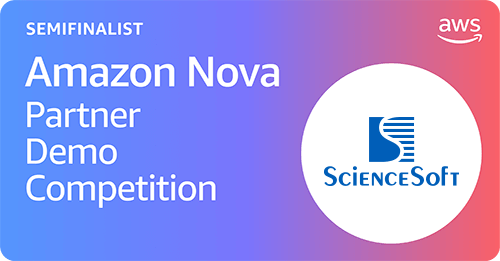How to Develop AI Software
Project Roadmap, Team, Sourcing Models
In data science and AI since 1989, ScienceSoft helps companies from 30+ industries create powerful software with artificial intelligence (AI) capabilities – promptly, cost-effectively, and with minimal risks.
Developing Software with AI Capabilities: Summary
Development of software with AI capabilities is a way for enterprises, tech startups, and software product companies to obtain an innovative solution that enables the end-to-end automation of tasks traditionally involving human intelligence.
Supported by AI, an application can automate even the most complex business operations, personalize service delivery, and deliver valuable case-specific insights. According to G2, 83% of organizations see positive ROI three months after implementing AI-powered solutions.
How to build AI software in 8 steps
- Analyze business needs (for enterprises); develop the competitive advantage framework (for software product companies).
- Choose between proprietary AI model development and pre-trained model integration.
- Design the solution architecture, software backend, integrations, and user-friendly UX/UI design.
- Code the server side of the solution and perform in-parallel testing.
- Develop the proprietary model or fine-tune the pre-trained one and deploy the model within the software. Scale and optimize the model according to the demonstrated results.
- Integrate the solution with corporate third-party systems (if applicable) and UI (a web page, an analytics dashboard).
- Introduce a corporate user adoption strategy (for enterprises).
- Ensure continuous solution evolution and maintenance to preserve accurate AI output and proactively fix arising issues.
With decades-long experience in AI and 750+ IT professionals on board, ScienceSoft can provide all the necessary competencies to help companies design and build top-quality AI software. We create flexible AI solutions with capabilities tailored to each customer’s unique requirements and guarantee AI compliance with the relevant legal frameworks.
Industry-Specific AI Benefits
How to Develop Artificial Intelligence Software
Below, our experts share a typical roadmap we follow to deliver top-quality software with AI capabilities. The final scope and duration of each step depend on the complexity of your solution and the requirements for AI model performance.
1.
AI-powered app concept elaboration and product design
- For enterprises: analyzing the existing infrastructure and processes to be enhanced with AI; TCO calculation; analyzing the business needs and end users’ expectations.
- For software companies: building the competitive advantage framework (e.g., identifying the target audience and major competitors, outlining app features crucial for winning the target audience, creating user personas and mapping their user journeys, building a go-to-market strategy).
- Defining functional and non-functional requirements for the solution, including exact AI capabilities, compliance with data privacy regulations, solution compatibility with other systems, etc.
- Defining the project scope, estimating costs and timelines, and creating a risk mitigation plan.
2.
Deciding on the optimal approach to the future ML model
-
Choosing the available pre-trained ML model most suitable to meet the required needs (e.g., a GPT model, a model from the SpaCy library, PyTorch Hub, etc.), considering the use case and goal, cost, data requirements, model complexity, how well-trained and scalable it is, etc.
-
Creating a proprietary ML model for non-standard, highly innovative or experimental use cases (including designing its architecture, training and optimizing the algorithm, hyperparameter tuning, cross-validation, and regularization).
3.
AI-powered software design
- Designing architecture, software backend, and integrations.
- User-friendly UX and UI design for the convenience of end users
4.
ML model development and implementation
- Data collection for ML model training and evaluation (internal company data, open-source and paid third-party data sets).
- Performing exploratory data analysis (EDA) to identify patterns in data and discover inconsistencies like errors and anomalies.
- Data cleansing (standardizing, replacing missing and deviating variables, anonymizing sensitive data) and labeling.
- Splitting the prepared data into training, validation, and test sets.
- Training and fine-tuning the model.
5.
Non-AI part development
- DevOps implementation: CI/CD pipelines, cloud automation, containerization tools, etc. Check our dedicated guide on DevOps implementation.
- Coding the server side of the AI-powered solution, including APIs for integration with other systems.
- Performing the required testing procedures throughout the development process.
6.
Deployment and integration
- Putting the ML model into action on live data within the solution to provide actionable output.
- Error handling and exception handling in the software to manage situations where the model encounters unexpected input or fails to provide a meaningful output.
- Configuring the infrastructure of the AI-powered software and implementing reliable network security mechanisms.
- Deploying the software with the integrated model to the target environment.
- Testing and validating the integrated model.
- Scaling and optimizing the model to ensure that the deployed model can handle the expected workload efficiently.
- Integrating the solution with corporate and third-party systems (if applicable).
- Performing integration with the UI (e.g., a web page, a customer portal, analytics dashboards).
- Testing the entire solution.
- Setting the AI solution live.
We typically start the AI software launch with pilot deployments to a limited number of users and run thorough user acceptance, integration, and compatibility tests. This way, we make sure the solution works well with the target software and infrastructure (incl. hardware) and can handle potential issues before a full-scale rollout.
7.
Introducing a tailored AI adoption strategy
Integrating AI in business-critical software may require organizational changes to ensure successful AI implementation and high adoption. ScienceSoft provides companies with practical assistance in:
- Upgrading corporate data policies to break down data silos across the departments, simplify access to data for the AI solution, and eliminate low-quality data that decreases AI output accuracy.
- Designing a plan to adapt employee workflows to the AI-powered software (involves planning time-framed AI launch initiatives and creating new role-specific policies).
- Drawing user tutorials and maintenance guides for in-house IT teams.
- Conducting employee training in a live, remote, or hybrid format.
8.
Continuous solution evolution and optimization
- Monitoring and optimization of AI-powered solution performance.
- Promptly detecting and fixing AI-related security and integration issues.
- Adjusting UX and UI based on user feedback.
- Fine-tuning and retraining the ML model for better accuracy.
- Adding new AI features if needed.
AI maintenance is a separately controlled process focused mainly on fixing AI ‘drifts’ – decreasing model accuracy and increasing bias when the data used for analytics grows in volume and starts deviating from the initial training set. In the case of such drifts, our experts tune the hyperparameters and retrain the model on a new data set reflecting shifts in data patterns. Sometimes, replacing the model with a new, higher-performing one is a more cost-effective option than trying to adjust the old model to the drifts.
Cost of Developing Software with AI Capabilities
The cost of software powered by artificial intelligence can vary greatly. The estimates rely heavily on the specifics of AI module development:
- The quality and volume of data used for AI and the number of data sources.
- Data type (unstructured data is more expensive to process than structured).
- Data origin (there may be a need to buy external data) and whether it needs labeling.
- Required accuracy rate for AI (the higher it is, the more time-consuming and expertise-demanding ML model tuning will be).
- The complexity of ML algorithms.
- Deployment type (AI outputs are in batches or in near-real-time).
- Infrastructure costs: cloud storage, security tools, etc.
Sample costs
From ScienceSoft's experience, the cost of AI software development may vary from $100,000 to $650,000+, depending on solution complexity.
$100,000–$200,000
An AI-powered solution that automatically extracts unstructured data from several sources, classifies it using an ML algorithm of moderate complexity, and provides outputs in batches.
$500,000–$650,000+
A complex AI-powered solution that processes data of various types from a large number of sources and relies on advanced, expertise-demanding ML algorithms of high accuracy.
Curious about the potential costs of developing AI solutions? Use our AI cost calculator to get a cost estimate tailored to your needs.
AI-Based Software Development Cost Estimation
Please answer a few questions prepared by ScienceSoft's AI consultants — within 24 hours, our team will carefully review your project details and calculate a free custom quote.
Learn more about our AI development services.
Thank you for your request!
We will analyze your case and get back to you within a business day to share a ballpark estimate.
In the meantime, would you like to learn more about ScienceSoft?
- Project success no matter what: learn how we make good on our mission.
- 4,200 successful projects: explore our portfolio.
- 1,400+ incredible clients: read what they say.

Sourcing Models of Developing Software with AI Capabilities
Why Choose ScienceSoft to Deliver Software Powered by AI
Deep multi-domain expertise
- Since 2005 in business intelligence and data warehousing; since 2013 in big data and image analysis services.
- Seasoned project managers, business analysts, solution architects, data scientists, software engineers, and QA experts having practical knowledge of 30+ industries, including healthcare, BFSI, manufacturing, retail, and telecoms.
- A full-scale project management office to run enterprise-level AI implementation projects.
- In-house compliance consultants to achieve AI software compliance with HIPAA, PCI DSS, GLBA, GDPR, and other necessary regulations.
- Since 2003 in cybersecurity to ensure world-class protection of AI-powered software and data it operates.
Guaranteed service quality
- Quality-first approach based on a mature ISO 9001-certified quality management system.
- Mature project management practices to achieve project goals despite time and budget constraints.
- ISO 27001-certified security management based on comprehensive policies and processes, advanced security technology, and skilled professionals.
Examples of AI-Powered Solutions ScienceSoft Develops
Advanced analytics
- Intelligent root cause analysis.
- Trend and anomaly identification.
- Forecasting quantitative values and events.
- Analytics-based object clustering and segmentation.
Recommendation engines
- Data-driven prescription of optimal operational decisions.
- Automated enforcement of pre-defined actions (for apps, smart robots, autonomous vehicles, etc.).
- AI-supported search and navigation.
- Image recognition and classification, including facial and emotion recognition.
- Dynamic and static object detection within an image or video stream.
- Action taking when certain visual patterns are detected.
Natural language processing
- Optical character recognition and sentiment analysis.
- Automated language translation.
- Speech recognition and transcription.
- Enforcing textual and voice commands.
AI-powered chatbots
- Processing written and spoken human requests.
- Real-time generation of relevant responses.
- Human-like textual and voice communication.
Generative AI
- User prompt processing and real-time conversation.
- Producing new forms of creative content (text, images, audio, video, and more) based on specified parameters.
Typical Roles on Our AI Solution Development Teams
Business Analyst
Analyzes business and end user needs and translates them into clear technical requirements for AI-powered software.
Solution Architect
Designs secure and scalable architectures for the AI-powered software and the integration solutions.
Compliance Consultant
Analyzes legal requirements for the AI-supported solution, advices on the proper compliance maintenance policies to implement.
Project Manager
Plans the project, manages the AI development life cycle, fosters collaboration between business and tech stakeholders.
Data Scientist
Cleanses the data for AI and engineers solution features; builds, trains, tests, and validates ML models.
UX/UI Designer
Creates wireframes, user journeys, and UI prototypes for AI-driven software following the principles of user-centricity.
Software Developers
Code the back end and APIs for AI-based software, create user interfaces, fix the bugs identified by QA experts, and further evolve the solution.
QA Engineer
Designs and implements a test strategy, a test plan, and test cases to validate the quality and security of the AI software, reports on the QA results.
Data Engineer
Deploys AI models in production, monitors their performance, and handles maintenance tasks.
Cloud Services We Recommend to Speed Up the Development of AI Solutions
AI platforms help quickly set up, automate and manage each stage of the AI module development with pre-configured infrastructure and workflows. ScienceSoft recommends considering platforms by major cloud providers: Amazon, Microsoft, and Google. All of them are leaders in Gartner’s Magic Quadrant for Cloud AI Developer Services and offer integrated development environments (IDEs) with the following capabilities:
|
|
Some of the platforms’ distinctive features are outlined below:

Amazon SageMaker
Description
- Enterprise-ready infrastructure offered by AWS (e.g., Amazon EC2 and Amazon S3-based) to support AI-related projects.
- Pre-configured data labeling workflows, access to pre-screened vendors offering data labeling services.
- One-click data import, 300 pre-configured data transformation and visualization capabilities.
- A unified repository to store, organize, and reuse ML features.
- A marketplace with pre-built ML algorithms and models.
Best for
Enterprise-scale AI integration initiatives.
Azure Machine Learning Services
Description
- Drag-and-drop UI for low-code model development.
- Data labeling service to manage and monitor labeling projects and automate iterative tasks.
- Flexible deployment options offered by Azure, including the hybrid cloud.
- Cost management with workspace and resource level quota limits.
best for
Flexible AI deployment (on-premises/hybrid cloud).
Google AI Platform
Description
- Accelerated AI performance due to integrated proprietary Tensor Processing Unit (TPU).
- Advanced support of Kubernetes orchestration.
- Integration with BigQuery (Google’s hyperscale data warehouse) datasets.
- Data labeling service that connects companies with human labelers.
- Support of TensorFlow Enterprise.
- Pre-configured virtual machines and optimized containers for AI based on deep learning.
best for
Integration of resource-intensive deep learning AI into software; startup-friendly.
Trust the Development of AI-Powered Software to Professionals
Having 36 years of experience in software development and data science, ScienceSoft has all it takes to deliver effective, high-performing software with AI capabilities.
We create an optimal feature set, architecture design, and tech stack for your AI-based software and evaluate its economic feasibility. You also receive a detailed project plan and get expert advice on AI security and compliance to prevent AI implementation risks.
Our experts develop the non-AI software part, design and implement AI models, establish the required integrations, and run all necessary QA procedures. In 3–5 months, you receive an MVP of your tailored AI solution and can start generating early payback.
AI-based solution audit and revamp
We perform an expert audit of your AI-powered software to identify its operational issues and suggest cost-effective ways to fix them. Our experts can quickly upgrade the software and retrain your AI models for >95% output accuracy to help you drive higher value with your existing solution.

About ScienceSoft
ScienceSoft is a global IT consulting and software development company headquartered in McKinney, Texas. For 36 years, we help companies design and build state-of-the-art software enhanced with AI and ensure smooth solution performance in the long run. In our AI development projects, we employ robust quality management and data security management systems backed up by ISO 9001 and ISO 27001 certifications.
















